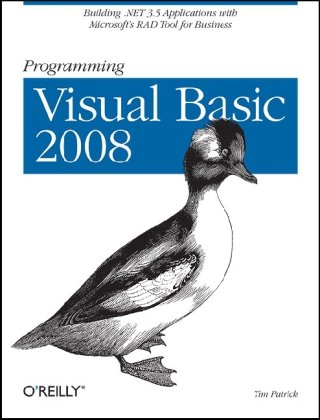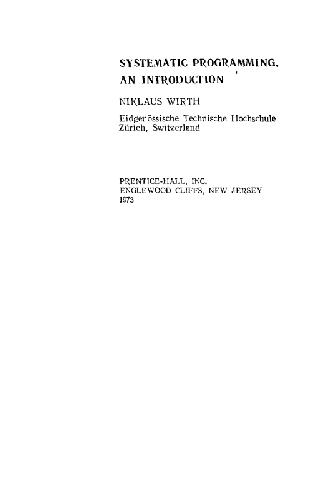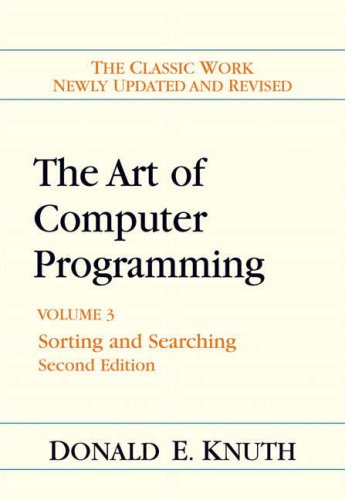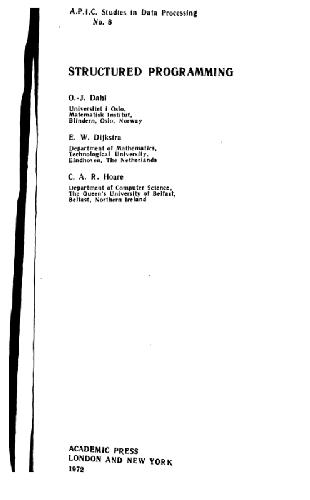Tim Patrick978-0-596-51843-1
VB language and its syntax An overview of the .NET Framework Object-oriented development in VB and .NET Generic objects, collections, and nullable types Design and management of software projects Integrating desktop features with Windows Forms Database design with SQL Server 2008 Database interface design with ADO.NET The new LINQ feature, and how to use it within VB and .NET Embedding XML within application source code Encryption and authentication in .NET Interacting with data stored in files and directories Web development using ASP.NET Deploying an application to a user’s workstation And much more
Programming Visual Basic 2008 is ideal for VB 6 programmers who are ready to move to .NET, as well as VB.NET programmers who wish to improve their project-focused software development skills. Programming novices and developers coming from other languages will find the book valuable because of its language instruction and project design knowledge. Once you finish the book, you will have a firm grasp of VB 2008’s core concepts and language elements, and understand how to build VB projects as they were intended — as complete, cohesive solutions.
Table of contents :
Programming Visual Basic 2008……Page 1
Table of Contents……Page 8
Who Is Reading This Book?……Page 16
What’s in This Book?……Page 17
Conventions Used in This Book……Page 18
How to Contact Us……Page 19
Acknowledgments……Page 20
Before .NET……Page 22
Back to Introducing .NET……Page 23
The .NET Object……Page 24
Objects and Data……Page 25
Objects and Interfaces……Page 26
Objects and Instances……Page 27
The Common Language Runtime……Page 28
The Common Language Specification……Page 29
The Common Type System……Page 30
.NET Class Libraries……Page 31
Metadata and Attributes……Page 34
Versioning……Page 36
From Source Code to EXE……Page 37
What About Visual Studio and Visual Basic?……Page 38
Visual Studio 2008……Page 39
Summary……Page 43
Project……Page 44
The History of the Visual Basic Revolution……Page 51
The Basics of Logic and Data……Page 53
Data Types and Variables……Page 56
Literals……Page 57
Variables……Page 58
Data Types……Page 60
Advanced Declaration……Page 62
Local Declaration and Fields……Page 64
Comments……Page 65
Option Statements……Page 66
Basic Operators……Page 68
Using Functions and Subroutines……Page 70
Conditions……Page 71
If Statements……Page 72
Select Case Statements……Page 73
IIf and If Functions……Page 74
For…Next Loops……Page 75
Do…Loop Loops……Page 76
Exit Statements……Page 77
Creating Your Own Procedures……Page 78
Subroutines……Page 79
Functions……Page 80
Properties……Page 81
The GoTo Statement……Page 82
The Return Statement……Page 84
Events and Event Handlers……Page 85
Namespaces……Page 87
Referencing Namespaces……Page 88
The My Namespace……Page 90
Project……Page 91
Introducing the Project……Page 96
Library Item Features……Page 97
Administrative Features……Page 98
The Application As a Whole……Page 99
Data and Information……Page 100
Usability……Page 101
Commonality……Page 102
The Life of a Project……Page 104
Documentation……Page 105
Design and Planning……Page 106
Project Approval……Page 107
Changes to the Project……Page 108
Acceptance Criteria Testing……Page 109
Ongoing Support……Page 110
Project……Page 111
Deliverables and Acceptance Criteria……Page 112
Library Item Features……Page 113
Administrative Features……Page 114
Project Estimate and Timetable……Page 115
Relational Databases……Page 116
SQL Server 2005……Page 119
DDL Statements……Page 121
DML Statements……Page 124
Beyond Basic SQL……Page 127
Using Databases in Visual Basic……Page 128
Documenting the Database……Page 129
Project……Page 130
Security-related tables……Page 131
Support code tables……Page 133
Library items……Page 134
Patron-related tables……Page 137
Bar code-related tables……Page 139
Other miscellaneous tables……Page 141
Creating the Database……Page 143
What Is an Assembly?……Page 147
What’s Inside an Assembly?……Page 149
Assemblies and Applications……Page 152
The My Namespace and Assemblies……Page 153
Directives and Assemblies……Page 155
Summary……Page 157
Project……Page 158
Adding Controls……Page 159
Adding the Code to the Form……Page 163
Setting the Version Number……Page 167
Adding the Main Form……Page 169
Save Your Work……Page 171
The Nature of Computer Data……Page 172
Data in .NET……Page 174
Decimal Data Types……Page 175
Boolean Data Type……Page 177
Value Types and Reference Types……Page 178
Visual Basic Data Types……Page 179
Literals……Page 180
Constants……Page 181
Enumerations……Page 182
Variables……Page 183
Variable and Constant Naming Conventions……Page 186
Local Type Inference……Page 187
Operators……Page 188
Arrays……Page 193
Array Boundaries……Page 195
Nullable Types……Page 196
Conversion Functions……Page 197
Date-Related Functions……Page 198
String Functions……Page 200
Summary……Page 202
Project……Page 203
Inside a Windows Application……Page 208
Everything Is a Window……Page 209
Messages and the Message Pump……Page 210
Window Procedures……Page 211
Designing Windows Forms Applications……Page 212
Working with Forms……Page 216
Adding Controls……Page 219
Events and Delegates……Page 227
Making Forms Useful……Page 231
Project……Page 233
Configuring the Splash Screen……Page 234
Configuring the Main Form……Page 236
Making the Program Single-Instance……Page 239
Object-Oriented Programming Concepts……Page 240
Abstraction……Page 241
Inheritance……Page 243
Polymorphism……Page 244
OOP in Visual Basic and .NET……Page 245
Class Members……Page 246
Shared Class Members……Page 249
Overloaded Members and Optional Arguments……Page 250
Inheritance……Page 251
Creating Instances of Classes……Page 253
Constructors and Destructors……Page 255
Interfaces……Page 258
Modules and Structures……Page 259
Partial Methods……Page 260
The MsgBox Method……Page 262
Using DoEvents……Page 263
ParamArray Arguments……Page 264
Supporting List and Combo Boxes……Page 265
Editing Code Tables……Page 268
The Generic Detail Form……Page 269
The Generic Summary Form……Page 271
Lambda Expressions……Page 274
Implying Lambdas……Page 276
Expression Trees……Page 277
Complex Lambdas……Page 278
Variable Lifting……Page 279
Object Initializers……Page 280
The Nature of Errors in Visual Basic……Page 281
Unstructured Error Handling……Page 284
Structured Error Handling……Page 286
The Catch Clause……Page 287
Unhandled Errors……Page 288
Generating Errors……Page 290
Mixing Error-Handling Methods……Page 291
The System.Exception Class……Page 292
The Err Object……Page 293
Summary……Page 294
General Error Handler……Page 295
Unhandled Error Capture……Page 297
ADO.NET……Page 298
What Is ADO.NET?……Page 299
Providers……Page 300
Data Sets……Page 302
Data Sets Versus No Data Sets……Page 303
Creating a Data Source……Page 305
Using a Data Source……Page 307
Data Binding……Page 309
Building the Connection String……Page 310
Using SQL Statements……Page 311
Modifying Data……Page 312
Database Transactions……Page 313
ADO.NET Entity Framework……Page 314
Project……Page 315
Reference the Data Namespaces……Page 316
Connecting to the Database……Page 317
Interacting with the Database……Page 319
Processing Data Values……Page 320
System-Level Configuration……Page 321
Security……Page 324
Cryptography and Encryption……Page 325
Data Stability……Page 326
Encryption in .NET……Page 327
Symmetric Cryptography……Page 328
Asymmetric Cryptography……Page 330
Hashing……Page 331
User Authentication and My.User……Page 332
Project……Page 333
Authentication Support……Page 334
Encrypting Passwords……Page 336
Undoing Some Previous Changes……Page 339
Managing Security Groups……Page 340
Managing Users……Page 346
Per-User Experience……Page 347
What Is Operator Overloading?……Page 351
What Can You Overload?……Page 353
Mathematical Operators……Page 354
Comparison Operators……Page 355
Bitwise and Logical Operators……Page 356
The CType Operator……Page 357
Other Operator Overloading Issues……Page 359
Declaration Requirements……Page 360
Extension Methods……Page 361
Overloading a Conversion……Page 363
Global Support Features……Page 364
Extending a Framework-Supplied Class……Page 365
Record Editors and Supporting Forms……Page 366
Search-limiting forms……Page 367
More named item support forms……Page 368
Inherited code editors……Page 371
Connecting the Editors to the Main Form……Page 380
Setting the Default Location……Page 381
What Is XML?……Page 382
The XML Rule……Page 385
Some Basic XML……Page 386
Some Basic—and Meaningful—XML……Page 387
What About the Human-Readable Part?……Page 388
XML Schemas……Page 389
XML Namespaces……Page 391
Using XML in .NET: The Old Way……Page 392
The Basic XML Classes, Basically……Page 393
Schema Verification……Page 395
Using XML in .NET: The New Way……Page 396
Embedded XML Expressions……Page 397
XML Axis Properties……Page 398
Summary……Page 399
Project……Page 400
Report Configuration File……Page 402
Create Report Entry Class……Page 403
Design the Report Form……Page 404
Populate Reports from Configuration File……Page 406
Running the Reports……Page 410
Connecting the Select Report Form……Page 412
A Short History of Settings……Page 413
Settings in Visual Basic 2008……Page 415
Adding Settings to a Project……Page 416
My.Settings……Page 419
Summary……Page 421
Update Technical Documentation……Page 422
User settings……Page 423
Add the Settings……Page 424
Caching and Using Settings……Page 425
Adding Configuration Forms……Page 427
Connecting to the Configured Database……Page 434
Files and Directories……Page 437
Traditional Visual Basic File Management……Page 438
Stream Features……Page 439
Using a Stream……Page 440
Beyond Stream Bytes……Page 441
Reading a File Via a Stream……Page 443
My Namespace Versus Visual Basic Commands……Page 445
Reading and Writing Files Through My……Page 447
Summary……Page 448
Configuring Log Output……Page 449
Other Log Output Options……Page 451
Obtaining a Bar Code Font……Page 452
What Are Generics?……Page 454
Data Type and Interface Constraints……Page 457
Simultaneous Constraints……Page 459
Non-Generic Types with Generic Members……Page 460
Generics and Collections……Page 461
Generic Nullable Types……Page 462
Managing Holidays……Page 463
What Is LINQ?……Page 469
The Bad……Page 470
Anonymous Types……Page 471
LINQ to Objects……Page 472
The From Clause……Page 474
The Select Clause……Page 475
The Where Clause……Page 476
Joining Sources……Page 477
Skip and Take……Page 479
Aggregate Queries……Page 480
Advanced Query Expressions……Page 481
LINQ to XML……Page 482
LINQ to DataSet……Page 484
LINQ to SQL……Page 485
Deferred Execution……Page 489
Summary……Page 490
Looking Up Library Items……Page 491
Maintaining Search History……Page 498
Showing Item Detail……Page 500
Enabling the Search Features……Page 504
User Interface……Page 507
Overview of GDI+……Page 508
Selecting a Canvas……Page 509
Disposing of Graphics Objects Properly……Page 510
Pens……Page 511
Brushes……Page 512
Flowing Text from the Font……Page 514
Imagining Images……Page 518
Exposing Your True Artist……Page 520
Paths: Drawings on Macro-Vision……Page 522
Keeping It Regional……Page 523
Twisting and Turning with Transformations……Page 524
Enhancing Controls Through Owner Draw……Page 526
Windows Presentation Foundation……Page 528
WPF and XAML……Page 529
Enhancing Classes with Attributes……Page 531
Project……Page 532
Using Owner Draw……Page 533
Bar Code Design……Page 537
Fun with Graphics……Page 545
Defining Globalization and Localization……Page 547
Resource Files……Page 548
The My.Resources Object……Page 550
Localizing Forms Within Visual Studio……Page 552
Adding Resources Outside Visual Studio……Page 555
Manually Compiling Resources……Page 556
Compiling Satellite Assemblies……Page 557
Other Localization Features……Page 558
Summary……Page 559
Tracking Patron Payments……Page 560
Patron Record Access……Page 561
Patron Password Modification……Page 562
Collecting Patron Payments……Page 563
Managing All Fines and Payments……Page 567
Connecting Patron Features to the Main Form……Page 570
Dueling Patron Management Forms……Page 571
Printing……Page 573
Printing in Windows……Page 574
Printing in .NET……Page 575
Printing a Document……Page 578
Print Preview……Page 580
Counting and Numbering Pages……Page 582
Printing in “Raw” Mode……Page 584
Supporting Raw Printing……Page 585
Printing Tickets……Page 589
Printing Bar Codes……Page 591
Support for Check-In and Checkout……Page 593
Checking Out Items……Page 596
Checking In Items……Page 599
Report Options in .NET……Page 602
XPS Documents……Page 603
Integration with Microsoft Office……Page 604
Using Reporting Controls in .NET……Page 605
Adding the Data Source……Page 606
Adding a Report Design Surface……Page 607
Designing the Report Surface……Page 608
Using a Report Control……Page 609
Running the Report……Page 610
Adding a Page Header and Footer……Page 611
Support for Grouping and Sorting……Page 612
Enhanced Style Formatting……Page 613
Using Custom Data……Page 614
Supplying Custom Data Sources……Page 616
Project……Page 618
Crafting the SQL Statements……Page 619
Adding Report Schemas……Page 621
Adding Reports……Page 622
Adding a Report Viewer……Page 623
Adding Built-in Reports……Page 626
Software Licensing Options……Page 632
License Agreement Only……Page 633
Generated Custom License Key……Page 634
Controlled Access……Page 635
License Agreements……Page 636
Obfuscation……Page 637
The Library Licensing System……Page 639
Generating the License File……Page 641
Summary……Page 642
License File……Page 643
Library License Helper Application……Page 644
Adding the License to the Library Program……Page 648
Enforcing the License……Page 653
Daily Item Processing……Page 656
How the Internet Works……Page 663
Programming the Internet……Page 665
ASP.NET Features……Page 666
Trying Out ASP.NET……Page 667
More About Events……Page 674
State and View State……Page 675
Data Validation……Page 676
Database Integration……Page 678
Windows Communication Foundation……Page 679
Project……Page 684
Configuring the Database……Page 685
The Default Page……Page 686
Search Results……Page 687
Search Detail……Page 690
Statistics Report……Page 691
Windows Online Help Options……Page 693
Microsoft Help 2……Page 694
Designing HTML Help……Page 695
Help Project File……Page 697
Help Contents File……Page 698
Help Keywords (Index) File……Page 700
HelpProvider Control……Page 701
Showing pop-up help……Page 702
ShowHelp Method……Page 703
Building the Help Files……Page 704
Adding Help Support to the Application……Page 705
What’s Involved in Deployment?……Page 710
Direct ASP.NET Deployment……Page 711
XCopy Deployment……Page 712
Windows Installer Deployment……Page 713
Step 3……Page 715
Step 5……Page 716
After the wizard……Page 717
ClickOnce Deployment……Page 719
Planning the Deployment……Page 721
Building the Setup Project……Page 722
The Distribution Media……Page 729
The Library Project……Page 732
Visual Basic Flexibility……Page 735
The Programming Mindset……Page 737
Summary……Page 738
Download the Software……Page 740
Install Project Templates……Page 741
Bar Code Support……Page 742
Terms of Use……Page 743
Index……Page 746







Reviews
There are no reviews yet.